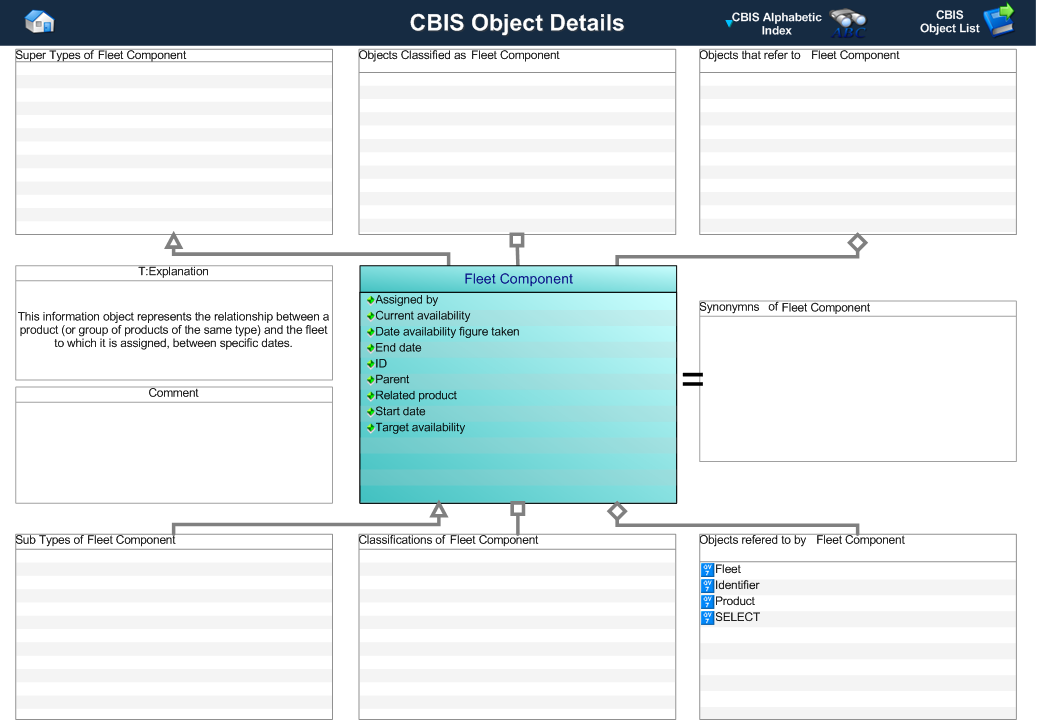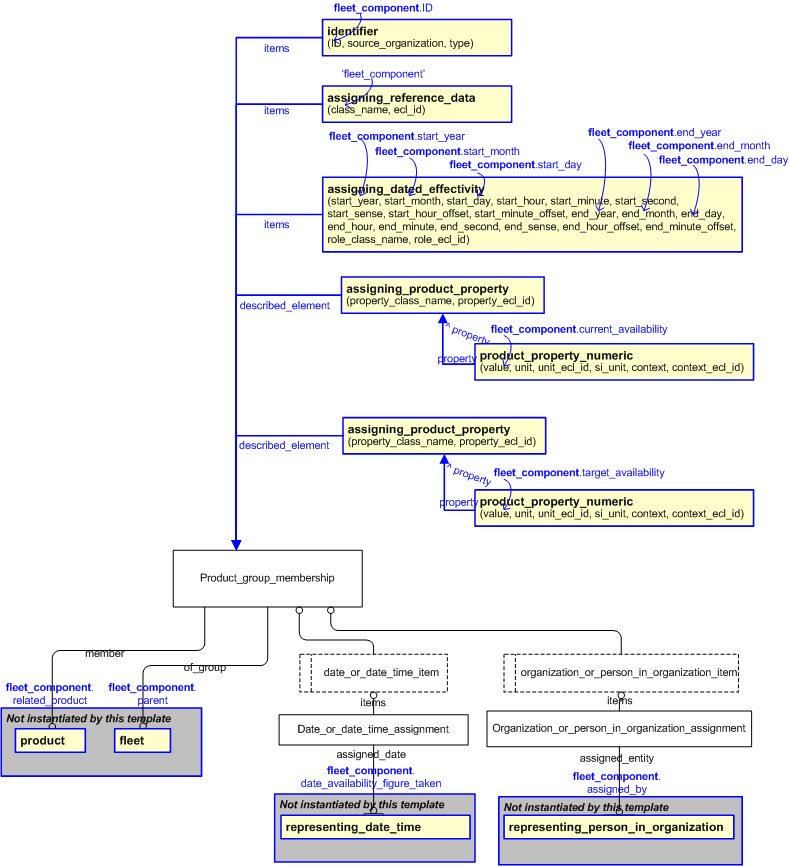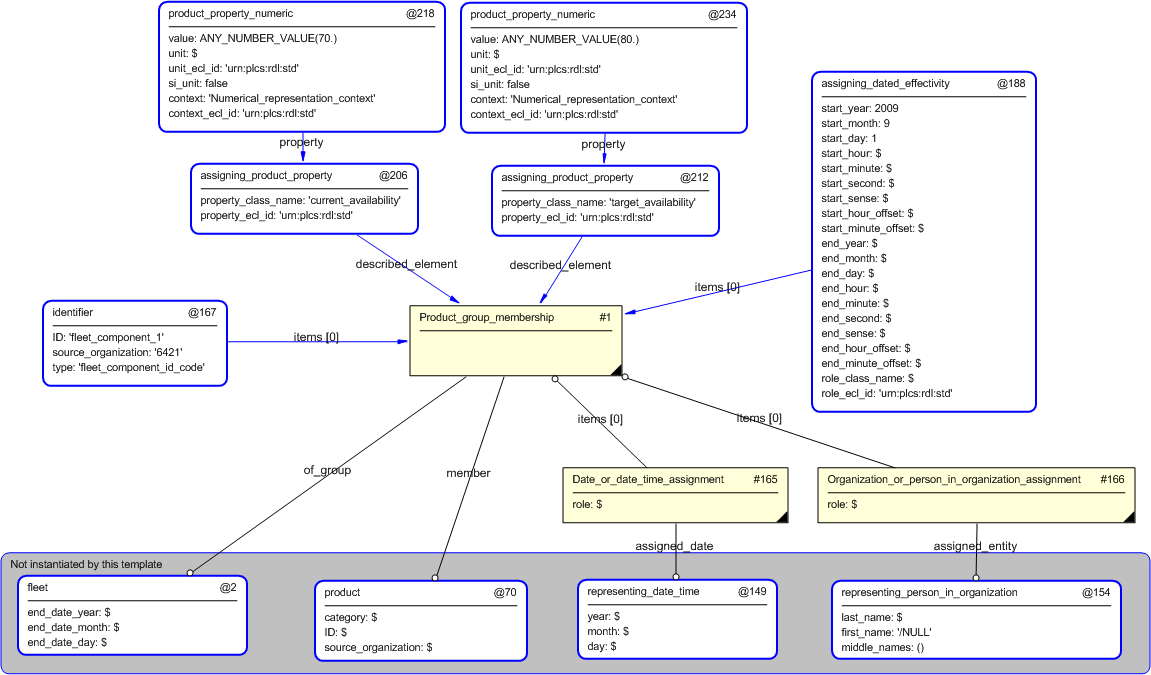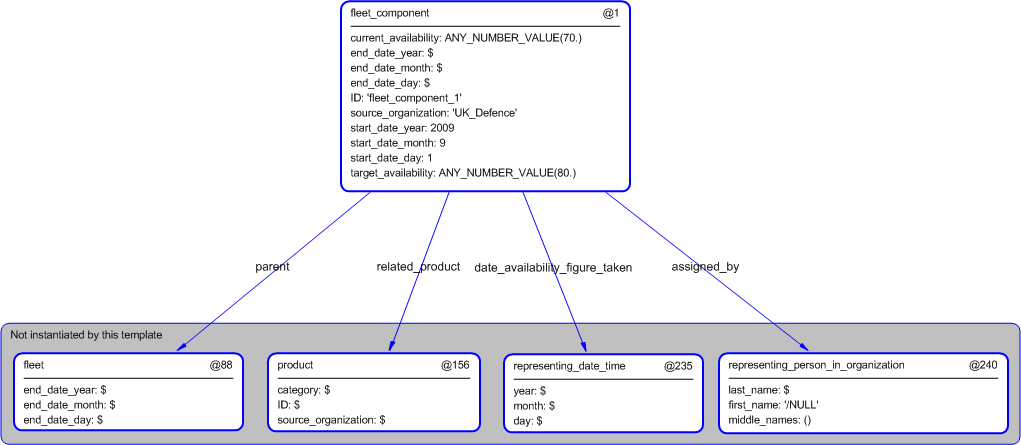Template:— fleet_component (flt_compnnt)
Context:— UK_Defence |
Date: 2010/03/15 14:22:42
Revision: 1.5
|
This section specifies the template fleet_component.
NOTE
The template has been defined in the context of
UK_Defence.
Refer to the business context for details of related templates.
NOTE
An explanation of a template and the associated instantiation path is
provided in the
Template overview
section.
This template describes how to represent the concept of a fleet component in terms of PLCS model elements (templates, entities,
and reference data).
A fleet component is the relationship between a product (or group of products of the same type) and the fleet to which
it is assigned, between specific dates.
This information object represents the relationship between a product (or group of products of the same type) and
the fleet to which it is assigned, between specific dates.
Figure 1 — A MOOD Business Architect representation of the Business Object: Fleet Component
The attributes of the Fleet Component object are tabled below.
|
Attribute name
|
Attribute description
|
Attribute type
|
Optionality
|
| Assigned by |
This is the reference to the person or organization that assigned the product to the fleet for the defined period. |
Relationship to Person or Organization |
Optional |
| Current availability |
This is the current availability for the product during its assignment to the fleet.
Availability may be quoted as a % value.
|
intrinsic |
Mandatory |
| Date availability figure taken |
This is the date on which the current availability was measured / calculated. |
intrinsic |
Optional |
| End date |
This is the date on which the product ceased to be part of the fleet. |
intrinsic |
Optional |
| ID |
This is the identifier of the fleet component. |
intrinsic |
Mandatory |
| Identifier.id |
This is the value of the id attribute of the Identifier applied to the fleet component. |
intrinsic |
Mandatory |
| Identifier.type |
This attribute is the type associated with the id of the Identifier given to the fleet component. |
fleet_component_id_code |
Mandatory |
| Identifier.source_organization |
This attribute is the value representing the source organization that provides the id of the Identifier given to the fleet
component. This value is assumed to be a type of Organization_identification_code.
|
Organization_identification_code |
Mandatory |
| Parent |
This is the reference to the fleet, of which the related product forms a part. |
Relationship to Fleet |
Mandatory |
| Related product |
This is the reference to the product(s) that forms part of the fleet. |
Relationship to Product |
Mandatory (1:?) |
| Start date |
This is the date on which the product was incorporated into the fleet. |
intrinsic |
Optional |
| Target availability |
This is the target availability for the product during its assignment to the fleet.
Availability may be quoted as a % value.
|
intrinsic |
Optional |
Table 1 — Fleet Component attribute details
The EXPRESS-G diagram in
Figure
2
shows the templates and EXPRESS entities that are required
to represent the template
"fleet_component".
The text highlighted in blue shows the template parameters.
Figure 2 — An EXPRESS-G representation of the Information model for fleet_component
The graphic for the template to be used in other EXPRESS-G diagrams
is shown in Figure
3
below.
Figure 3 — The graphical representation of the fleet_component template
The following input parameters are defined for this template:
This is the reference to the person or organization that assigned the product to the fleet for the defined period.
This is the current availability for the product during its assignment to the fleet.
This is the reference to the date on which the current availability was measured / calculated.
This is the year component of the end date on which the product ceased to be part of the fleet.
This is the month component of the end date on which the product ceased to be part of the fleet.
This is the day component of the end date on which the product ceased to be part of the fleet.
This is the identifier of the fleet component.
The organization that created the associated identifier. Additionally
a Person or Information System could be defined when either of these are the source; see Identifier template characterizations.
This is the reference to the fleet, of which the related product forms a part.
This is the reference to the product(s) that forms part of the fleet.
This is the year component of the date on which the product was incorporated into the fleet.
This is the month component of the date on which the product was incorporated into the fleet.
This is the day component of the date on which the product was incorporated into the fleet.
This is the target availability for the product during its assignment to the fleet
The following reference parameters are defined for this template:
Allow the
External_class
entity instantiated in this path to be referenced when this template is used.
Note: The
External_class
entity can be referenced in a template path by:
%^target = $fleet_component.ext_class%
The instantiation path shown below specifies the entities that are to be
instantiated by the template.
A description of templates and the syntax for the instantiation path is
provided in the
Templates Help/Information section.
Product_group_membershipProduct_group_membership.of_group ->
@parentProduct_group_membership.member ->
@related_product%^prod_grp_mem =
Product_group_membership%
-- ID /
identifier(
ID=@ID,
source_organization=@source_organization,
type='fleet_component_id_code',
items=^prod_grp_mem)/
-- end and start dates /
assigning_dated_effectivity(
start_year=@start_date_year,
start_month=@start_date_month,
start_day=@start_date_day,
start_hour='',
start_minute='',
start_second='',
start_sense=''exact',
start_hour_offset='',
start_minute_offset='',
end_year=@end_date_year,
end_month=@end_date_month,
end_day=@end_date_day,
end_hour='',
end_minute='',
end_second='',
end_sense=''exact',
end_hour_offset='',
end_minute_offset='',
role_class_name='',
role_ecl_id='urn:plcs:rdl:std',
items=^prod_grp_mem)/
-- current availability /
assigning_product_property(
property_class_name='current_availability',
property_ecl_id='urn:plcs:rdl:uk_defence',
described_element=^prod_grp_mem)/
%^property_current = $assigning_product_property.property%
/
product_property_numeric(
value=@current_availability,
unit='',
unit_ecl_id='urn:plcs:rdl:std',
si_unit='false',
context='Numerical_representation_context',
context_ecl_id='urn:plcs:rdl:std',
property=^property_current)/
-- target availability /
assigning_product_property(
property_class_name='target_availability',
property_ecl_id='urn:plcs:rdl:uk_defence',
described_element=^prod_grp_mem)/
%^property_target = $assigning_product_property.property%
/
product_property_numeric(
value=@target_availability,
unit='',
unit_ecl_id='urn:plcs:rdl:std',
si_unit='false',
context='Numerical_representation_context',
context_ecl_id='urn:plcs:rdl:std',
property=^property_target)/
-- assigned by Organization_or_person_in_organization_assignmentOrganization_or_person_in_organization_assignment.role = 'fleet_component_assigned_by'
Organization_or_person_in_organization_assignment.assigned_entity ->
@assigned_byOrganization_or_person_in_organization_assignment.items ->
^prod_grp_mem
-- date availability figure taken Date_or_date_time_assignmentDate_or_date_time_assignment.assigned_date ->
@date_availability_figure_takenDate_or_date_time_assignment.role = 'fleet_component_date_availability_taken'
Date_or_date_time_assignment.items ->
^prod_grp_mem
The following entities are instantiated with attributes as specified:
The instance diagram in Figure
4
shows an example of the EXPRESS entities and templates that are instantiated by the template:
/fleet_component(assigned_by='#154', current_availability='70', date_availability_figure_taken='#149', end_date_year='', end_date_month='', end_date_day='', ID='fleet_component_1', source_organization='6421', parent='#2', related_product='#70', start_date_year='2009', start_date_month='09', start_date_day='01', target_availability='80')/
(an illustration of the consolidated fleet_component template is shown in
Figure
5 below.)
Figure 4 — Entities instantiated by fleet_component template
The instance diagram in
Figure
5
shows the graphic symbol for the template that is to be
used in other instance diagrams. The example template is:
/fleet_component(assigned_by='#154', current_availability='70', date_availability_figure_taken='#149', end_date_year='', end_date_month='', end_date_day='', ID='fleet_component_1', source_organization='6421', parent='#2', related_product='#70', start_date_year='2009', start_date_month='09', start_date_day='01', target_availability='80')/
Figure 5 — Instantiation of fleet_component template
Characterizations
No common characterizations of the template
fleet_component
have been identified. However, the ISO 10303-239 EXPRESS model
may enable other assignments to the entities instantiated by the template.




